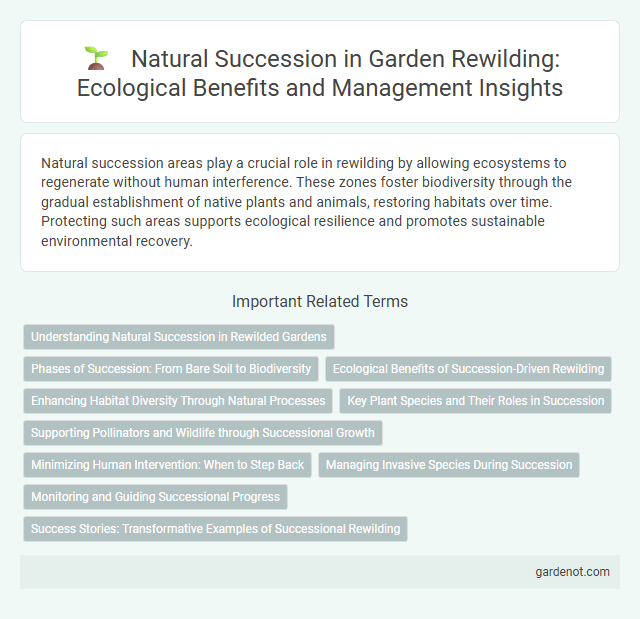Natural succession areas play a crucial role in rewilding by allowing ecosystems to regenerate without human interference. These zones foster biodiversity through the gradual establishment of native plants and animals, restoring habitats over time. Protecting such areas supports ecological resilience and promotes sustainable environmental recovery.
Understanding Natural Succession in Rewilded Gardens
Natural succession in rewilded gardens involves the gradual process where plants and ecosystems evolve without human intervention, allowing native species to establish and thrive. This dynamic progression creates diverse habitats, supporting increased biodiversity and ecosystem resilience. Monitoring these changes helps gardeners promote sustainable, self-regulating landscapes that mimic natural environments.
Phases of Succession: From Bare Soil to Biodiversity
Natural succession initiates on bare soil as pioneering species such as lichens and mosses establish, gradually enriching the soil with organic matter. Mid-successional plants like grasses and shrubs then colonize, creating habitats that support diverse insect and bird populations. The climax community emerges with mature forests or stable grasslands, fostering high biodiversity and ecosystem resilience within rewilding projects.
Ecological Benefits of Succession-Driven Rewilding
Succession-driven rewilding enhances biodiversity by promoting a natural progression of plant and animal communities that restore ecosystem resilience. These self-sustaining habitats improve soil health, increase carbon sequestration, and create diverse niches supporting pollinators and apex predators. The gradual development of complex vegetation structures fosters wildlife corridors, stabilizes local climate, and accelerates habitat connectivity across fragmented landscapes.
Enhancing Habitat Diversity Through Natural Processes
Natural succession areas promote habitat diversity by allowing native plant species to develop through uncontaminated ecological processes, supporting a wide range of wildlife. This dynamic progression fosters complex vegetation structures and microhabitats, crucial for sustaining biodiversity. Enhancing these natural processes minimizes human intervention, leading to resilient ecosystems and improved ecosystem services.
Key Plant Species and Their Roles in Succession
Key plant species in natural succession areas play pivotal roles in ecosystem development by initiating soil stabilization and nutrient cycling. Pioneer species such as willows (Salix spp.) and alders (Alnus spp.) enrich soil fertility through nitrogen fixation and create favorable microhabitats for subsequent flora. These foundational plants facilitate habitat complexity, enabling diverse plant communities and accelerating rewilding progress.
Supporting Pollinators and Wildlife through Successional Growth
Natural succession areas provide essential habitats by allowing native vegetation to develop undisturbed, creating diverse layers of plants that support pollinators and wildlife. The gradual progression from grasses to shrubs and trees fosters food sources and nesting sites, increasing biodiversity and ecosystem resilience. Supporting successional growth enhances pollination services and wildlife corridors, crucial for maintaining healthy, self-sustaining rewilded landscapes.
Minimizing Human Intervention: When to Step Back
Natural succession areas thrive when human intervention is minimized, allowing ecosystems to evolve through intrinsic processes. Recognizing when to step back requires understanding key ecological indicators, such as native species colonization and soil regeneration. Effective rewilding hinges on balancing cautious monitoring with letting natural forces restore biodiversity and habitat complexity autonomously.
Managing Invasive Species During Succession
Managing invasive species during natural succession is critical to ensuring native biodiversity thrives within rewilding projects. Targeted removal techniques and continuous monitoring help control invasive plants and animals that disrupt ecosystem balance and hinder succession progress. Restoring native species dominance accelerates habitat resilience and promotes sustainable ecological recovery.
Monitoring and Guiding Successional Progress
Natural succession areas require careful monitoring to track vegetation changes, species diversity, and habitat structure over time. Guiding successional progress involves targeted interventions such as controlled planting or selective removal of invasive species to support native ecosystem recovery. Data-driven approaches enhance adaptive management strategies, ensuring the restoration of ecological functions and biodiversity resilience.
Success Stories: Transformative Examples of Successional Rewilding
Natural succession areas showcase transformative rewilding success stories where ecosystems recover complexity and biodiversity without human intervention. Iconic examples include the Chernobyl Exclusion Zone and Yellowstone National Park, where natural processes have restored habitats and wildlife populations. These sites demonstrate how successional rewilding promotes ecosystem resilience, carbon sequestration, and habitat connectivity over time.
Natural succession area Infographic

 gardenot.com
gardenot.com